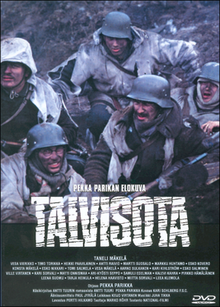|
The Winter War (film)
The Winter War (Finnish: Talvisota) is a 1989 Finnish war film directed by Pekka Parikka, and based on the novel Talvisota by Antti Tuuri. It is set in the 1939 Winter War and tells the story of a Finnish infantry regiment from Southern Ostrobothnia fighting on the Karelian Isthmus, focusing mainly on a platoon of reservists from Kauhava. The Winter War was released in Finland on 30 November 1989. It was Finland's most popular film with over 600,000 admissions.[2] It won six Jussi Awards and was Finland's entry for the Best Foreign Language Film at the 63rd Academy Awards, but was not accepted as a nominee. PlotOn 13 October 1939, reservists of the Finnish Army are called up for active duty as the threat of Soviet invasion becomes likely. Martti and Paavo Hakala, two farmer brothers from Kauhava, Southern Ostrobothnia, join other men from the municipality in a half-platoon under the command of Second Lieutenant Jussi Kantola. After mustering at the local school, the men ride the train to Seinäjoki to join the rest of the Finnish Army's 23rd Regiment, under the command of Lieutenant-Colonel Matti Laurila. After weeks of practice, the regiment goes to the Karelian Isthmus, where Kantola's men help civilians evacuate their village in the potential war zone. Laurila gives a speech to the regiment before marching to the Taipale River, where Kantola's men help in building defenses in preparation for the anticipated Soviet attack. On 6 December, the Battle of Taipale begins on Finnish Independence Day, and the Finns are shelled by Soviet artillery advancing to the frontline. The Red Army gathers outside the Finnish trenches, and the next day the Finns are strafed by the Soviet Air Force as the Red Army launches a human wave attack with T-26s, but hold them back. Paavo is wounded and sent home, where he attends the funeral of four Kauhava men killed in the attack. Paavo recovers and returns to the front, but is soon killed in a direct hit from Soviet artillery in front of Martti. Several times, the Soviets attack and enter the Finnish trenches, but the Finns manage to push them back. Kantola is ordered to retake a casemate captured by the Soviets when he left it unattended, with the Finns driving out the Soviets but suffering high casualties in the assault and destroying the casemate. On 27 December, the Soviets halt their attack on the Taipale front and Kantola's men go to Yläjärvi for rest and recuperation, and Martti manages to get home leave. When Martti returns, the unit goes to Vuosalmi near the village of Äyräpää to prevent the Soviets from crossing the Vuoksi River. The Finns try to fend off Soviet human wave attacks but are overwhelmed and Martti is almost killed when a Soviet soldier buttstrokes him, forcing the Finns to retreat. On 5 March, Martti, Kantola and the surviving Finns cover a counterattack by the men of Nurmo, but a delay allows the Soviets to get into an advantaged position. The Finns face more human wave attacks and are overwhelmed by the mass of Soviet soldiers. On the morning of 13 March, the Finns are almost overrun when the fighting stops at eleven o’clock as the Moscow Peace Treaty takes effect. CastSource:[1]
Production notesMilitary hardwareThe film depicts a wide array of genuine wartime vehicles and artillery; and when these were not available, replicas were used:
Animated special effects were used to simulate tracer projectiles. MusicIn addition to the main title and the incidental music, five pieces play an important role in the film:
AwardsPekka Parikka was nominated for the Golden Bear at the 40th Berlin International Film Festival in 1990.[4] At the Jussi Awards (Finland's premier film awards) the same year, Talvisota received six awards:
Taneli Mäkelä also won Best Actor, for his role in the film, at the Rouen Nordic Film Festival.[5] TV seriesAn extended television movie version was also made, consisting of five episodes, each with a running time of around 55 minutes. The series has been aired four times on Yle TV2, in 1991, 1999, 2009 and 2015. Home videoThere are three cuts of the film:[citation needed]
The abridged international cut was released on DVD and VHS in various non-Finnish countries and Blu-ray in Germany. The original Finnish theatrical version had a 4K digital restoration in 2013[6] as well as various DVDs, has been released on Blu-ray in Finland, Germany and Japan. As of June 2018, the extended TV version has only been released on a basic 2-DVD set in Finland. It is non-anamorphic, has only 2.0 stereo audio and no subtitles or extras.[7][8] See also
References
External links |
||||||||||||||||||||||||||
Portal di Ensiklopedia Dunia
